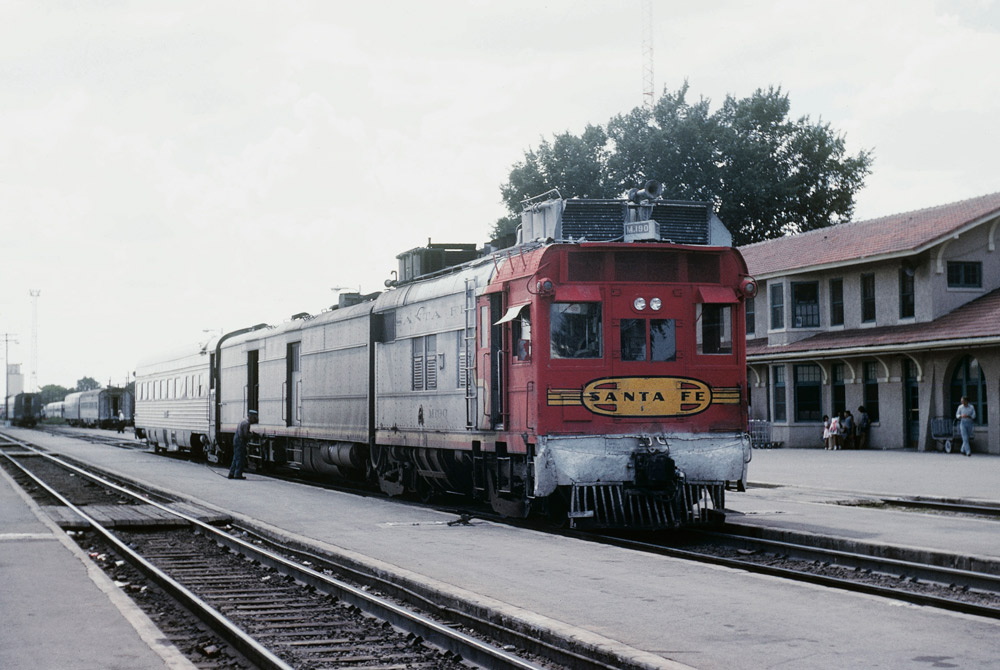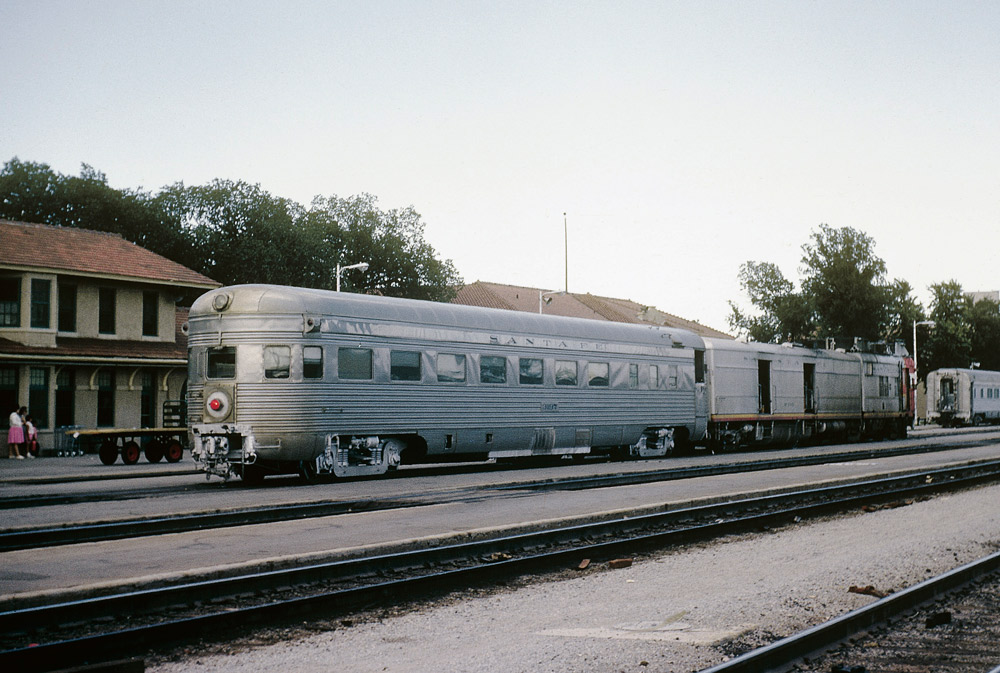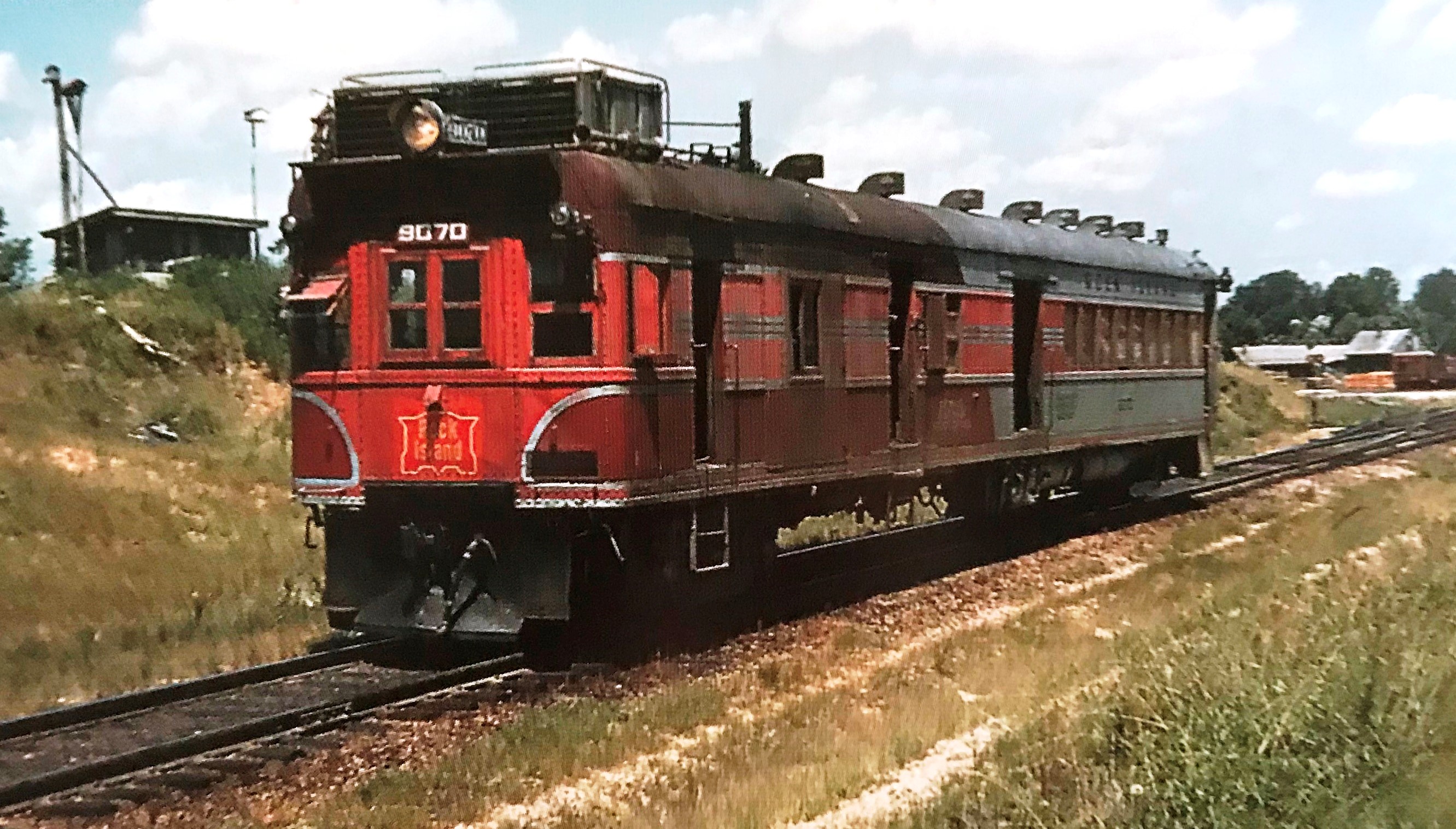There is at least one other piece of railroad equipment operating with a Hamilton engine, although it's not a Lima-Hamilton locomotive. That is PRR #4666, a J.G. Brill doodlebug with a Hamilton diesel engine for propulsion. The #4666 has kicked around all sorts of tourist lines, including the Arcade & Attica Railroad, the Penn View Mountain Railroad, the New Hope & Ivyland Railroad, the Black River & Western Railroad, and the Wilmington & Western Railroad.. As of 2016, it belongs to the Allentown & Auburn Railroad in Kutztown, Pennsylvania, who has gotten it running again and is in the process of fully restoring it. I wonder if the PRR reused that headlight, and possibly the bell, off of a retired steam locomotive. It certainly looks like one of their locomotive headlights.

NickD said:A CPR SW8 works a ferry at Windsor, Ontario. Check out the counterweight system used to work the landside ramp.
Look closely at the far shore, looks like the Boblo boats over there.
Thanks for the "float" section. Lots of Michigan pics here!
In addition to that awesome old PRR doodlebug, the Allentown & Auburn is also the owner and operator of the oldest, regularly-operated diesel locomotive in the United States, EMC SW #206. It was built in 1937 by Electro-Motive Corporation for Bethlehem Steel's Philadelphia, Bethlehem & New England Railroad as #206 and operated there for a decade before being sold to the Steelton & Highspire Railroad in Steelton, PA. Sometime around 1955, it was rebuilt, with an 800hp 567 replacing the obsolete 600hp Winton 201A, although it retained it's original electrical system. In December of 1967, the #23, as it had been renumbered, was sold to the Maryland & Pennsylvania Railroad and renumbered again to #83. While the Ma & Pa kept #83 in service, it was mostly kept in their roundhouse due to its age. On June 27, 1986 the Ma & Pa leased #83 to the Stewartstown Railroad, and the Stewartstown Railroad purchased the locomotive one month later in August of 1986. Renumbering it #11 to fit their roster, #11 was used for freight and passenger trains on the Northern Central Railway trackage in New Freedom, PA and very rarely ever made it to Stewartstown, PA due to deteriorating track conditions. In 1997, #11 was moved to Jim Thorpe, PA and used for Rail Tours Inc.'s operation. George Hart was involved with the Ma & Pa, the Stewartstown RR and Rail Tours Inc., so I imagine he officially owned it and just moved it between his operations. Keeping it’s number, #11 was used as a yard switcher and for tourist trains. When Rail Tours Inc. ceased running train in 2005 #11, along with most of the rest of the equipment, was sold to the Reading & Northern Railroad. One year later the Allentown and Auburn Railroad purchased the locomotive. It would spend a couple of years stored in Pittston, PA before arriving at the railroad’s interchange in Topton, PA in 2014. Engine #11 was renumbered #206, returning it to its as build number. Soon after #206 was painted Pullman green to resemble similar engines used by the Reading Railroad.

Although this is a photo charter, the #206 does handle the occasional freight move as well. It's run as their primary passenger power as well, due to essentially being an SW8 under the skin. If it was still Winton 201A powered, it's unlikely it would run often, if at all.

Even older than Allentown & Auburn #206 is DL&W #426, an EMC end-cab switcher which was produced so early that it doesn't even have a model name. It was built in 1935 at General Electric's Erie, PA plant, because Electro-Motive Corporation hadn't even built their McCook, IL factory yet, and it used GE's truck design, instead of the standard AAR switcher truck that EMC/EMD typically used. The styling on it is also really weird, with the half-height front grille and the steam locomotive-style headlight perched above the end of the hood. The #426, and a sister that was #425, were purchased by the DL&W, then eventually sold to Bethlehem Steel (seemed to be a home for old switchers) and had the Winton 201A removed and replaced with a 576, similar to A&A #206. Eventually it was purchased by Genesee Valley Transportation's Delaware-Lackawanna, moved back to Scranton, repainted to it's original appearance, and spends the vast majority of it's time at Steamtown NHS on display around the turntable. It may be older than the #206, but it can't even be remotely considered "regularly operated".




An amusing before and after of a D&H hi-rail '72 Plymouth. The story was that the D&H had had some cars derail on Richmondville Hill and Joe Cassick was the superintendent sent out to check on efforts to retail the cars. So he got the car on the tracks at the nearest grade crossing and drove up to the derailment and parks the car. He's helping rerail cars and chocking the wheels, and a freight pulls up on the same tracks at the bottom of the hill and stops and ties down. All of a sudden the rerailed cars, which have no air in the brakes and aren't coupled to the rest of the train, kicked the chocks and started rolling down the hill. They collected his hi-rail and then took it down the hill and squished it against the power parked at the bottom of the hill. According to some of the D&H vets who knew him, they wished Cassick had been in the car when it happened.
Santa Fe M-190, an unusual articulated doodlebug constructed by Electro-Motive Corporation in 1932, at Clovis, NM with a single round-tail observation car in tow. The M-190 was a two-unit machine that rode on three trucks, and was delivered with a 900hp Winton engine that was configured to run on petroleum distillate (think somewhere between gasoline and kerosene). The lead unit had the engine, generator, and controls, while the second unit was a baggage car, and the whole thing was designed to tow a single coach for passengers. Most of your doodlebugs could tow a "trailer", which was a specially-designed, short, lightweight car that could be configured for added passengers or baggage or even a railway post office, but the M-190 had the guts to tow a full-length passenger car. In 1949, ATSF dumped the old Winton distillate engine for a conventional 900hp EMD 567, and the M-190 soldiered on into the '60s. In this photo, taken in '63, it was assigned to a Clovis-Carlsbad connecting service for the Chief.


Pete Gossett (Forum Supporter) said:NickD said:
This pic makes me want to see some old muscle car converted into a hi-rail vehicle.
I could see that in some sort of Mad Max-esque apocalyptic setting. Rail infrastructure tends to be pretty robust and would survive years of neglect and still be able to support a hi-rail vehicle with ease.
Its kind of amazing how long ATSF M-190 lasted, considering that by and large, the doodlebug was largely a short-lived creation. Most of them were dead and buried before the '50s. They were a victim of a number of factors.
The first was that there was no real mechanical uniformity to them. You had a variety of manufacturers, like McKeen, Budd, Pullman, St. Louis Car Company, Edwards Rail Car Company and Wason Manufacturing Company, building them in a variety of configurations, like gas-mechanical, diesel-mechanical, gas-electric and diesel-electric, with components from companies chosen almost at random. There were GE and Westinghouse electrical systems, engines from Winton, Fairbanks-Morse, Macintosh & Seymour, Cooper-Bessemer, Cummins, Brill, Mack, and many others.
The second was that they were fairly primitive for the time, and as a result, pretty unreliable. Frisco, for example, bought theirs to take over passenger service on some of their lightly trafficked branches, and found that the reliability was so terrible that they ended up modernizing a handful of 1880s-era 4-4-0s at their Springfield shops and using them to replace the doodlebugs. Lucius Beebe's Mixed Train Daily shows several shortlines where their doodlebugs had packed it in and refused all efforts at reviving it, and so they ended up just towing them in their train behind a steam locomotive like a conventional passenger car. Those cool steampunk McKeen motorcars were noted to be especially awful. They lacked a dedicated reverse mechanicsm in their transmission, and so to reverse one, you had to shut the engine off, go underneath and swap the timing chains from one set of camshafts to a different set that would make the engine run backwards. Yeah.
The third was that after the Great Depression, a lot of the railroads began cutting back their passenger service on branch lines just as fast as they could, and so the motorcars quickly found themselves out of a job.

East Broad Top has M-1, which is a fascinating narrow-gauge J. G. Brill motorcar built by East Broad Top at their shops in Rockhill Furnace. Brill sold EBT one of their knock down kits to build it themselves, which included an interesting engine manufactured by Brill themselves (originally intended for use in airships, Brill lost the contract and instead repurposed them for use in their motorcars) Westinghouse motors and generators, air tanks, and trucks. East Broad Top built the body and the frame in their own shops, cut down the trucks from standard gauge to 3-foot gauge, and swapped out the provided Westinghouse traction motors, which wouldn't fit the narrowed trucks, for traction motors from an electric mine locomotive. . The trucks are reported to have been cut down from standard gauge ones without changing the dampener, which causes harmonic wobbles at certain speeds. At 12 mph or below or 18 mph or faster the rocking motion does not occur. Those who have ridden in the cab say it's a fascinating machine to watch the engineer control, because in addition to controlling the throttle and the spark advance on the engine, the engineer has to manually control the field on the generator, so there is a lot going on.

On the other end of EBT M-1, which was a standard gauge design that was cut down to 3-foot gauge, you have Lancaster, Oxford & Southern #10 at Strasburg, which was a 3-foot gauge design that was widened to standard gauge. The #10 is believed to be the only piece of surviving equipment from the LO&S and is also believed to be the only one of its kind built by the Sanders Machine Shop of Havre de Grace, MD. Built approximately to standard-gauge dimensions in 1914, the car seated 46 and carried two tons of freight. The car could make the Oxford-Quarryville trip of 19.5 miles in an hour and five minutes. After abandonment of the Little, Old & Slow in 1919, the car was converted to standard gauge and operated by the Grasse River Railroad in upstate New York until 1960, then spent some time in New Hampshire at the Wolfeborough Rail Road. It was eventually moved south, where it is run by the Strasburg Rail Road on select occasions.

Not a doodlebug, but an early EMC boxcab. Delivered as a pair, ATSF #1 and #1A, this pair of 4-axle EMC boxcabs packed two 900hp Winton diesels in each unit, for a 3600hp pair. Certainly an odd-looking machine, with the cobra-like hooded air inlets on the front and the strange olive, dark blue, red, and yellow livery. They handled themselves fairly well in passenger service though, and paved the way for ATSF's acceptance of the EMC FT and the EMC E1.

A later rebuild of the EMC boxcabs added a hilariously stubby bulldog nose and a unibrow-like radiator, and there was an unpowered axle added to the outside of each truck, giving them a 1B-B1 wheel arrangement. It took an aesthetically questionable machine and made it look largely different, but it didn't make it look better.
In reply to NickD :
One of your comments above reminds me that somewhere I should have pictures of the old Frisco Springfield engine shop when it was BN. I think it has been torn down, I seem to recall it was missing last time I went through that part of town a few years back.
In reply to eastsideTim :
My father talks about in the '80s he went down and walked through what was left of the Delaware & Hudson's roundhouse in Oneonta. It had been the largest in the world, with 52(!) stalls and a 105-foot turntable. Crazy to think that the D&H, which rostered 375 steam locomotives at its peak and had only two named passenger trains, had the largest roundhouse, and not PRR or NYC or ATSF. They demolished 36 of the stalls in the '50s after steam was retired, and pretty much abandoned it after that, moving most of their facilities to Colonie. He said by that point in time it was pretty decrepit, and by '93, the remainder had been leveled.
The NYO&W's last surviving roundhouse had been here in Rome, NY. I remember riding past it on my way to school. The turntable pit was filled in, but you could see the outline, and the roundhouse was just three stalls with the roof pretty much gone. But the walls were still sound. Sadly, it was demolished in 2014. The NYO&W preservationists have never been a large or wealthy group. The last major buildings left now, after the Middletown shops burned 2 or 3 years ago, are the partially burned and fully abandoned Middletown station and headquarters (there's been talk of renovating it for decades but nothing ever happens) and the old freight house in Utica.
In reply to NickD :
Me and my wife recently went to the Unadilla (NY) Historical Society presentation. There was a discussion on all the rail lines and workers in the Oneonta local. Very interesting history of the area. Freight still runs through here Sidney, Unadilla). My wife won't let me put a penny on the rails when the train is coming through. Many years ago, we used to do that when the trains were running in northen New Jersey (Marcella, Green Pond area). That line stopped operating in the late '60's, early '70's. I don't know who ran the line though.
In reply to Dirtydog (Forum Supporter) :
Unadilla would be the old D&H. New York, Susquehanna & Western ran it in the '80s after they became the designated operator for the D&H when Guilford bankrupted the D&H in 1988. Then Canadian Pacific bought the D&H in 1991 and took over that line, and then in the 2000s, they sold off the southern portion of the D&H to Norfolk Southern. Ironic, because Norfolk & Western had owned the entirety of the D&H from 1968 to 1980 and then sold the whole thing off to Guilford for pennies.
Various D&H motive power inside the Colonie Diesel Shops (with the charming slogan of "Where Big Things Happen!")
That's one of the RS-3ms in the foreground. D&H sent a batch of 8 remaining RS-3s out to Morrison-Knudsen to have them upgraded with 2000hp 251 V12s. M-K also chopped the front hood, moved the dynamic braking grids to a boxy enclosure in the rear hood, and raised the rear hood by several inches. D&H vets joked that the #504 was likely recieving a new wheelslip indicator and buzzer after they had burned out. The D&H learned that 2000hp was too much for an RS-3 frame and weight and they were extremely prone to wheelslip, earning them the nickname of "clubfoots". The orange RS-3 behind it belongs to subsidiary Greenwich & Johnsonville, which the D&H sold off in 1982 to become the Batten Kill Railroad. The RS-3, #4116, went with it and still operates there today.

D&H RS-36 #5022. The #5022 was actually the last D&H Alco still operating on the property, hanging on until October of 1993, two years after Canadian Pacific bought out the D&H. Theis photo was taken over a decade earlier, some time in 1982.

D&H C420 #401, still wearing Lehigh & Hudson River colors. The L&HR's C420s were inherited by Conrail in 1976, but Conrail had no real interest in keeping Alcos on the roster, especially because the L&HR C420s lacked dynamic brakes. Conrail was unloading them in 1980, and the D&H bought L&HR #29/Conrail #2077 to use as a parts donor for their own ex-Lehigh Valley C420s. The #29/#2077 arrived on the property and was found to actually be in pretty good shape and run fairly decent, so the D&H slapped some new logos on it, renumbered it to #401 and put it to work. It was later renumbered to D&H #420 under Guilford, and today is still running as Arkansas & Missouri #58.

I have no clue what the hell the deal is with the barrels and planks is in the foreground. In the background is one of the #500x-series high-nose Alco RS-11s. Alco had built five RS-11s for New York Central, without any actual order from the the NYC, and even painted them in NYC lightning stripes, and then the NYC refused delivery of them. Between the NYC's poor financial condition and likely the issues with the earlier 244-powered machines, the NYC wanted nothing to do with them. They sat at Selkirk Yard, and then the D&H was in the market for more power and Alco put them in contact with the NYC. D&H cut a deal for the them, and was so impressed with the NYC livery that they decided to change theirs (at the time a simple black with yellow chevrons) to the new lightning stripe look.

You'll need to log in to post.